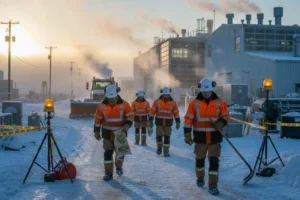Overview of Hot Work
Hot work is a typical job that carries a lot of risk in construction, shipbuilding, oil and gas, and manufacturing. Even though building, maintaining, and repairing homes requires wood, it also creates many fire and safety risks. It is important to know what hot work means, why it is risky, and how to deal with it safely in any workplace. Enrolling in a Hot Work in Construction course can help workers understand these hazards better and learn best practices for safe operations.

This blog covers all aspects of hot work, starting with its definition and moving on to the typical tasks, permits, laws, training, and best safety habits. The more complex industrial activities become, the higher the risks from hot work, so it is now more important than ever to have awareness and a plan for safety.
All types of hot work such as cutting steel beams or soldering pipes, involve their special challenges and duties. Knowing about these factors allows workers and employers to stop accidents from taking place.
What Do We Mean By Hot Work?
Hot work is any job that involves flames, sparks, or a lot of heat. According to the Health and Safety Executive (HSE), it is work that includes burning, welding, or using equipment that could cause nearby materials to ignite. Basically, anything that could cause a fire is called hot work. Completing Hot Work training can help workers understand these risks and learn how to perform such tasks safely.
Hot work activities are usually:


Welding is the process of joining metals with heat or a flame.

Soldering involves melting a filler metal to join different metal parts without melting the main metals.

Cutting: With oxy-fuel torches, you can divide metals into various pieces.

Brazing: In this process, the filler metal is melted at temperatures higher than those in soldering.

Grinding: Shaping or smoothing metal by making sparks.
What Makes Hot Work Dangerous?
As the heat and sparks hot work produces can quickly ignite nearby things. Dust or vapors can explode even hours after work if sparks from grinding or welding travel 35 feet and come into contact with them. Many fires caused by hot work start as invisible smoldering and then turn into flames.

Flammable gases or vapors in enclosed or poorly ventilated areas can make explosion risks very high. On top of this, fumes released by coatings or base metals can affect people’s breathing. Burns, heat exhaustion, electric shock, and dehydration are other dangers workers can experience.
According to the National Fire Protection Association (NFPA), hot work leads to about 4% of all industrial fires in the U.S. every year. A refinery explosion in Texas happened because of improper hot work, demonstrating the importance of having tough safety oversight.
What Does A Hot Work Permit Mean?
You must have a hot work permit, and a written safety document before you can start hot work in non-designated areas. With this document, the company can manage and evaluate risks properly.
It covers information about:

The kind of hot work that needs to be done

Who takes care of the job

The particular place

Hazards found

Things you should do to avoid accidents

Phone numbers for emergency help
A typical permit is issued for just one shift or day to maintain safety. The site manager or safety officer is the right person to issue and sign the permit.
What the Law Requires and How to Become Trained
Both employers and employees are required by law to ensure hot work is safe. Businesses are needed to examine risks, apply safety measures, and supply the right PPE and training to their workers.

Every employee should use the proper procedures, and safety equipment and tell their supervisor if they notice any risks. Failure to meet these duties can result in government action or serious accidents at work.
Moreover, teaching should be changed depending on the job and any hazards present. Those who use hot work equipment should know how to do so safely, notice any dangers, and handle emergencies. Regularly holding refresher courses and toolbox talks keeps safety important and helps everyone obey current rules. High-risk activities, including hot work, must be trained for and supervised according to the Control of Substances Hazardous to Health (COSHH) and the Regulatory Reform (Fire Safety) Order 2005.
Steps To Take To Keep Your Key Safe
Safety during hot work is achieved by planning and performing the task correctly. The following tips will help you avoid accidents:

Step 1: to organize the work area.
Begin by checking what is happening around the workplace. Either remove anything that could burn from the area or put flame-retardant blankets over them. Turn off anything nearby that might heat up or start a fire.
Step 2: Get the Hot Work Permit.
You should have a valid permit for hot work before you start. As a result, all risks are identified and steps to respond to them are set up.
Step 3: Put Fire Prevention Plans in Place
Keep fire extinguishers, fire blankets, or hoses close by. During the job and for at least 30–60 minutes after, have a trained fire watch observe the area.
Step 4: Put on the Right Protective Equipment
Workers should be given flame-resistant clothing, safety goggles or welding shields, insulated gloves, respirators, and anti-static footwear when required.
Step 5: Let Fresh Air into the Area
In rooms that don’t have much airflow, use fans or exhaust systems to remove fumes. This helps keep the vehicle safe by avoiding harmful fumes and lessening heat inside.
Step 6: Separate the area where work is being done
Set up signs, use tape, or block off the hot work area. Make sure all people on the site are informed about the ongoing hot work and its risks.
Step 7: Make Sure All Tools Are Ready
Before you begin, check all tools, hoses, and machines. Fires and injuries often occur because of damaged equipment.
Step 8: Monitor the Work After Completion
Following the job, watch the area to make sure no sparks or smoldering material are left. When a fire is delayed, that does not make it any less serious.
To stay safe during hot work, begin by thoroughly examining the work area to identify ignition sources and potential hazards. Conduct a Job Hazard Analysis (JHA) to tailor specific safety measures. Ensure all personnel are familiar with emergency exits, alarm locations, and firefighting equipment, and conduct regular fire drills.
Maintain detailed records of hot work permits, training, inspections, and incident reports to support audits and enhance safety. Some companies now use digital tracking systems for permits and inspections, improving adherence monitoring, reducing incidents, and enabling quicker response times.
Conclusion
Even though hot work happens regularly, it isn’t without dangers. Because it can lead to fires, explosions, and health problems. Ensure all personnel are familiar with emergency exits, alarm locations, and firefighting equipment, and conduct regular fire drills.
Maintain detailed records of hot work permits, training, inspections, and incident reports to support audits and enhance safety. Some companies now use digital tracking systems for permits and inspections, improving adherence monitoring, reducing incidents, and enabling quicker response times.
Use the guide and turn to the HSE for reliable information and tools. Safety is something you develop by building a culture, not just by meeting requirements. A little spark can lead to something important, so we should focus on making its growth positive, rather than harmful.





